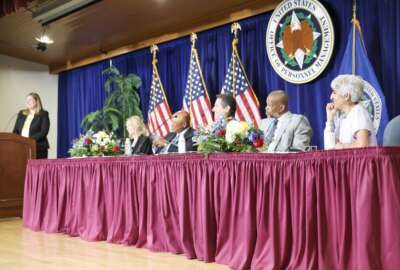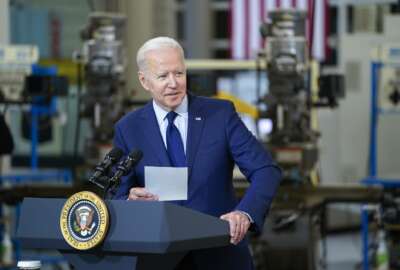
The CHCO Council’s role is growing, but major recruitment and retention challenges remain
OPM is trying to give CHCOs more opportunities to offer feedback on planned policy changes, as long-standing federal recruitment challenges endure.
The idea of the “future of work,” once a vague phrase with no real timeline, reached a recent turning point at the Office of Personnel Management.
OPM outlined its vision for agencies for what the federal workforce should look like in years to come. The guidance, published in March, defined the future federal workforce as one that’s “inclusive, agile and engaged.”
But in the work leading up to the guidance, and in the process of defining what the future of work actually meant for agencies and employees, OPM turned to leaders at the forefront of the federal workforce: agency chief human capital officers.
The human capital leaders convene regularly as part of the Chief Human Capital Officers (CHCO) Council, helmed by Margot Conrad, the council’s executive director. The council’s 2022 report to Congress, published in May, detailed CHCOs’ collaboration efforts over the last year, including their work on the OPM guidance.
“We spent a lot of time really digging into, ‘what does the future of the workforce really look like?’” Conrad said in an interview with Federal News Network. “We were able to collaboratively come up with a vision from the federal workforce. And from that, ultimately, OPM did put out a memo this spring that’s really laying a marker for what that future state is that we aspire to. It was a great example of CHCOs coming together with OPM in partnership to really put together a vision for that future state.”
Although expected to work in tandem with the CHCO Council, OPM in recent years had underutilized the council, the National Academy of Public Administration (NAPA) said in a 2021 report. The relationship was also complicated by an attempted merger between OPM and the General Services Administration during the Trump Administration. OPM resumed full stewardship of the CHCO Council in July 2021, after the staff, budget and administrative resources that supported the CHCO Council moved from OPM to GSA in December 2019.
Now almost two years after the CHCO Council moved back to OPM, Conrad said the agency is trying to give CHCOs even more opportunities to offer feedback on planned policy changes. OPM recently began holding office hours for CHCOs on ideas in the works, such as paid internship guidance and proposed regulations for 10-year term appointments. OPM also hosted a fall forum — the first in several years — to hear CHCOs’ input on some of the agency’s proposals.
“As human capital leaders, CHCOs offer critical input. They strengthen our policies and deliver feedback in real-time, allowing us to provide timely support to help federal agencies deliver on their respective missions,” Kiran Ahuja, OPM director and CHCO Council chairwoman, said in the council’s report to Congress.
“This next year is really going to be about doubling down”
Stemming from many of the conversations between the CHCO Council and OPM, Conrad said there were several areas of success over the past year, such as expanding the use of pooled hiring, shifting the focus in hiring from education to skills and standing up new council working groups to discuss areas of acute concern within the federal workforce.
Much of OPM’s work with the council ties back to the President’s Management Agenda (PMA), Conrad said. For example, one of the council’s newest working groups on recruitment and outreach is specifically targeting some of the goals of the first priority of the PMA — strengthening and empowering the federal workforce. Another council working group on employee engagement, also connected to strategies in the PMA, is considering ways to improve retention.
“This is a great opportunity for us to be really looking at, what are some of the barriers to recruitment and outreach? How are we measuring the effectiveness of recruitment and outreach? We’re really digging into a lot of these things,” Conrad said.
But despite efforts over the last year, there are remaining areas of concern for the future of the federal workforce. The council has already been considering ways to approach the large-scale problems, but for Conrad, the CHCO Council is now taking on a new direction.
“This next year is really going to be about doubling down and crystallizing our priorities within the working groups that we have and making sure that we are able to deliver on the goals and objectives that we’ve set forward,” Conrad said.
The biggest barriers to federal recruitment, retention
The CHCO Council, in both the report to Congress and in conversations with OPM, said there should be more investment across the board for human capital management, including for hiring and developing early career talent, fixing pay compression and standards for senior-level positions and addressing skills gaps in the federal IT and cybersecurity workforce.
Recently, the council has been focusing on further expanding the use of pooled hiring — the method of using shared certificates to hire multiple candidates off of a single job announcement. It’s a recruitment strategy many agencies employed to hire staff under the Infrastructure Investment and Jobs Act, commonly known as the Bipartisan Infrastructure Law.
“We’ve hired more than 5,000 people to support the Bipartisan Infrastructure Law through some of these new tools, by partnering together and doing pooled hiring. We’ve seen some great success,” Conrad said.
But pooled hiring is just one strategy for addressing many broad workforce challenges. The length of the hiring process, outdated IT systems and skills gaps among human resources (HR) employees themselves make workforce problems all the more complicated to solve.
“HR specialists are overwhelmed, lack the bandwidth and capacity to get hiring certificates issued quickly and do not have dedicated resources to focus on digital talent hiring,” the CHCO Council report said. “Generally, HR talent in the federal government is scarce, and there is fierce competition amongst agencies for this talent pool.”
Pooled hiring is one strategy that could prove effective, at least on the recruitment end, to strengthen the HR workforce at agencies. In one example, agencies hired 82 HR specialists off of one job announcement for the Bipartisan Infrastructure Law.
“Sharing certificates and being able to hire HR talent en masse to help support the HR workforce more broadly across government is one way that we’re starting to address that challenge,” Conrad said.
But beyond recruitment of the HR workforce, CHCOs said there is a major need to try to improve retention as well. Retention rates for HR management experts consistently fall behind the governmentwide average. The average retention rate for the federal workforce overall is 77.2%, while federal HR officials have a 69.7% average retention rate.
To try to address retention, Conrad said within the next year she plans to work with the council to create an HR career growth platform and portal including HR workforce training and career development resources, to offer more development options to HR professionals. Creating the platform is a goal contained in the PMA, with a deadline of the last quarter of fiscal 2023.
“There’s a lot of tangible work to address things that CHCOs have identified in the report, and that’s very much connected with the President’s Management Agenda,” Conrad said.
“The dollars aren’t matching the rhetoric”
The goal of creating the HR career growth platform is just one example of how the PMA aims to address recruitment and retentions challenges in the federal workforce. But there is more work the Biden administration has planned out as part of the PMA.
“This work includes efforts to look at the HR workforce from both an agency perspective to identify successful workforce management practices and an enterprise perspective to leverage shared resources and approaches,” the PMA said.
Some of the Biden administration’s PMA deadlines are approaching, including creating an HR competency model to try to close skills gaps, as well as designing a multi-lane career path model for HR specialists.
But the problems may be even deeper-rooted, and some have concerns that the focuses of the PMA aren’t necessarily driving the results needed, or looking at the problems the CHCO Council specifically described in its report to Congress.
Jason Briefel, director of government and public affairs at law firm Shaw Bransford and Roth, said there is a disconnect between the goals of the PMA and where the council said the problems really lie.
“To me, that’s a real question mark, and a real problem,” Briefel said in an interview. “The CHCO Council report clearly said that the fundamentals are not working. HR specialists are overwhelmed, they lack the bandwidth and capacity to get hiring certificates issued quickly do not have dedicated resources.”
A lot of it will come down to resources. Briefel said the federal HR workforce needs the budget to back up many of the Biden administration’s plans. The 2024 budget request references, for example, fixing pay compression and adding recruitment talent teams to streamline hiring. The administration said it’s also planning to create a new senior executive position at OPM focused on the development and career paths for the federal HR workforce. But details of how the administration plans to address these goals remain to be seen.
Further adding to the challenge, the possibility of adding more funding for human capital management is highly uncertain, as agencies prepare for cuts to spending as part of debt ceiling negotiations.
“What I hear from CHCOs directly is there is no money for them in their agencies, in their CHCO shops, in their operations. There is no money to fix their IT systems or to upgrade or modernize them,” Briefel said. “The dollars on the table, at the end of the day, aren’t matching the rhetoric.”
Copyright © 2025 Federal News Network. All rights reserved. This website is not intended for users located within the European Economic Area.
Drew Friedman is a workforce, pay and benefits reporter for Federal News Network.
Follow @dfriedmanWFED





